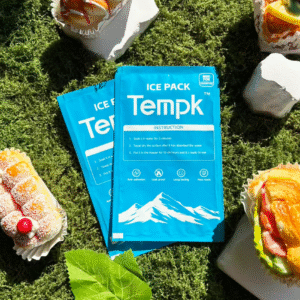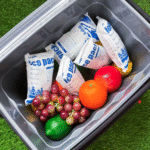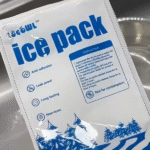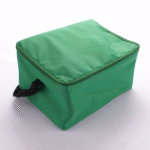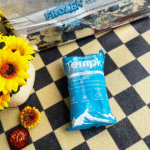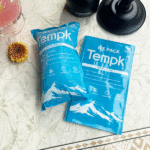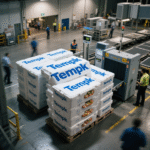Quando você precisa manter produtos congelados por dias, uma bolsa de gelo comum não vai resolver. UM folha de gelo seco resistente usa um design robusto de múltiplas camadas e um refrigerante ultrafrio para fornecer frio extremo sem vazamentos. Em apenas alguns parágrafos você aprenderá como essas planilhas funcionam, o que os torna duráveis e seguros, e por que eles estão se tornando uma solução para 2025 cadeias de frio. As chapas resistentes combinam um núcleo de polímero reticulado com plástico resistente e camadas não tecidas para suportar manuseio brusco e temperaturas de até –190 °C. Este artigo revela os detalhes usando linguagem simples e exemplos do mundo real.
O que é uma folha de gelo seco resistente? – definição, 4 construção de camadas e características principais usando frases de cauda longa como “manto de gelo seco de polímero reticulado”
Como ativar e dimensionar sua planilha? – etapas de hidratação, dicas de congelamento e regras práticas para calcular quantas folhas você precisa para sua remessa
Onde são usadas folhas resistentes? – aplicações específicas da indústria farmacêutica, comida, comércio eletrônico e recreação ao ar livre
Como ele se compara aos pacotes de gel e materiais de mudança de fase? – prós, contras e considerações de custo
Quais são as regras e regulamentos de segurança? – ventilação, equipamentos de proteção e limites de envio
O que 2025 tendências importam? – sustentabilidade, Sensores IoT e inovações na cadeia de suprimentos
O que é uma placa de gelo seco resistente e por que isso é importante?
Resposta principal: Uma folha de gelo seco resistente é uma almofada de refrigerante flexível projetada para fornecer temperaturas ultra frias enquanto resiste a perfurações e vazamentos. Cada folha contém várias camadas: duas camadas têxteis não tecidas encapsulam um refrigerante de polímero de poliacrilato reticulado, e duas camadas de plástico resistente com microperfurações são coladas ao tecido. O polímero pode ser congelado até –190 °C e geralmente é resfriado em freezers a –80 °C.; freezers domésticos levam de –18 °C a –21 °C. Estas folhas são aprovadas pela FDA, não tóxico e reutilizável.
Explicação expandida: projeto, materiais e desempenho térmico
Ao contrário dos pacotes de gel descartáveis que retêm água, mantas de gelo seco resistentes dependem dióxido de carbono sólido (gelo seco) e uma matriz polimérica. O polímero central absorve água durante a ativação, formando células individuais que permanecem flexíveis quando congeladas. Esta estrutura confere à folha a sua construção de 4 camadas:
Camadas externas de plástico resistente – Fabricado em polietileno de alta densidade ou filmes compósitos, essas camadas oferecem resistência à perfuração e microperfurações que liberam gás CO₂ gradualmente. Eles protegem o núcleo do refrigerante do contato direto com a carga e permitem que a chapa sobreviva ao manuseio brusco.
Camadas têxteis internas não tecidas – Fibras sintéticas fiadas proporcionam flexibilidade e resistência. Eles distribuem o frio uniformemente e evitam o vazamento do polímero.
Núcleo de gel de polímero reticulado – Um copolímero de poliacrilato superabsorvente absorve várias vezes seu peso em água. Quando congelado, ele se comporta como gelo seco, mantendo temperaturas bem abaixo de –78,5 °C e sublimando sem deixar líquido. Em produtos avançados, o polímero congela a –190 °C.
O resultado é uma folha que começa como uma folha plana, filme leve e, quando hidratado, incha em uma grade de células que podem ser cortadas no tamanho certo. Porque é flexível, a folha se adapta a itens irregulares e reveste as paredes de refrigeradores ou caixas de transporte.
Tabela de materiais e o que eles significam para você
| Componente | Função | Benefício para você |
| Lonas plásticas resistentes | Fornece resistência à perfuração e microperfurações para liberação controlada de gás | Proteja as remessas contra vazamentos e permita a sublimação segura |
| Camadas têxteis não tecidas | Adicione força e flexibilidade | A folha pode ser dobrada em torno de itens irregulares sem rasgar |
| Polímero reticulado | Absorve água; congela a temperaturas extremamente baixas | Mantém temperaturas ultrabaixas, permitindo remessa congelada de vários dias |
| Sublimando núcleo de gelo seco | CO₂ sólido se transforma diretamente em gás | Nenhum resíduo líquido; evita embalagens encharcadas |
Dicas práticas para ativar e usar folhas resistentes
Hidrate-se adequadamente – Para ativar uma camada de gelo seco, mergulhe-o em água morna e amasse até que as bolhas de ar escapem. Isso permite que o polímero absorva água e inche; cada célula deve estar totalmente hidratada antes de congelar.
Congelar completamente – Congelar a folha hidratada por pelo menos 24 horas. Os congeladores rápidos podem atingir –80 °C, mas os congeladores domésticos a –18 °C–21 °C também funcionam. Quanto mais fria for a temperatura inicial, mais tempo a folha permanecerá congelada.
Corte para caber – As folhas resistentes são projetadas com células individuais que podem ser cortadas no tamanho certo sem vazar. Corte entre células para criar formatos personalizados para kits de refeição, caixas de laboratório ou transportadores médicos.
Use massa suficiente – Para melhor desempenho, use pelo menos uma folha para cada 7–8 litros de espaço mais fresco. Mais massa prolonga a duração do resfriamento.
Coloque por cima – Posicione a folha acima de seus produtos; Air frio afunda, então esse arranjo maximiza o resfriamento.
Caso do mundo real: Uma equipe de pesquisa da vida selvagem que transportava amostras de DNA usou placas de gelo seco resistentes em vez de pelotas soltas de gelo seco. Hidrataram e congelaram duas folhas, colocou-os em torno de frascos em uma caixa isolada de 10 litros e manteve temperaturas abaixo de –60 °C por 48 horas. As folhas flexíveis protegiam os frascos contra choques e evitavam danos causados pela umidade. Um registrador de dados confirmou que as temperaturas permaneceram dentro da faixa exigida durante todo o voo transcontinental.
Como tamanho, ativar e manter placas de gelo seco resistentes?
Resposta direta: regras de dimensionamento e congelamento
As diretrizes de dimensionamento dependem do peso e da duração da remessa. Para remessas noturnas, use metade do peso da sua carga em gelo seco; capas de peso igual 48 horas, e 1.5 × o peso da carga útil fornece até 72 horas. Porque as folhas resistentes combinam polímero com gelo seco, essas regras práticas continuam sendo um bom ponto de partida. Por exemplo, um 5 kg de pedido de alimentos congelados enviado para 48 horas devem incluir cerca de 5 kg de gelo seco distribuído em várias folhas. Sempre teste em condições reais para confirmar o desempenho.
Explicação expandida: hidratação, congelar e reutilizar
Etapa de hidratação – Mergulhe a folha em água morna e amasse até que as células estejam totalmente saturadas. Mantenha a folha imersa até que as bolhas de ar parem de subir e as células inchem. A água quente acelera a hidratação em comparação com a água fria.
Etapa de congelamento – Após a hidratação, congele a folha plana por pelo menos 24 horas. Os congeladores comerciais podem atingir –80 °C; freezers domésticos atingem –18 °C a –21 °C. Temperaturas iniciais mais baixas produzem tempos de espera mais longos.
Embalagem e ventilação – Embale a folha com o lado do tecido voltado para o produto e certifique-se de que a embalagem tenha aberturas ou lacres soltos para que o gás CO₂ possa escapar. Evite recipientes herméticos; use refrigeradores isolados ou caixas projetadas para gelo seco.
Cuidados pós-embarque – Após o uso, permitir que a folha retorne à temperatura ambiente. Reidratar se as células encolheram, então congele novamente. Os lençóis são reutilizáveis até que a superfície têxtil se torne anti-higiénica ou danificada. Armazene em um armário ou freezer bem ventilado entre os usos.
Evite misturar com gelo normal – A combinação de uma camada de gelo seco resistente com gelo de água faz com que a água gelada derreta e absorva a energia da camada, reduzindo o desempenho. Mantenha-os separados.
Tabela de dimensionamento: peso e número de folhas
| Peso da carga útil (kg) | Duração do envio | Mantas de gelo seco recomendadas | Explicação |
| 2 kg | 24 horas | Uma folha padrão para serviços pesados | Use metade do peso da carga útil em gelo seco para remessas noturnas |
| 5 kg | 48 horas | Duas folhas (peso igual) | Peso igual de gelo seco mantém temperaturas congeladas até 48 horas |
| 10 kg | 72 horas | Três folhas (1.5 × peso) | 1.5 × o peso da carga útil é necessário para remessas de 72 horas |
| 1 kit refeição kg | 24 horas | Meia folha | Use seções de corte menores para reduzir peso e custo |
| 20 kg de remessa farmacêutica | 48 horas com sensores de temperatura | Quatro a cinco folhas mais monitores IoT | Sensores garantem conformidade; folhas adicionais fornecem redundância e mantêm requisitos rígidos de temperatura |
Dicas e sugestões fáceis de usar
Planeje com antecedência para viagens longas: Congele folhas extras e embale-as em um segundo refrigerador. Troque-os em seu refrigerador principal quando o primeiro conjunto descongelar.
Produtos pré-resfriados: Congele ou refrigere seus produtos antes de embalar; começar a frio prolonga o tempo de espera.
Deixe espaço para expansão: Ao congelar, deixe um recuo do tamanho de um polegar em cada célula para que o polímero possa se expandir sem estourar.
Use isolamento adequado: Combine folhas resistentes com recipientes isolados ou painéis a vácuo para retardar a transferência de calor.
Exemplo real: Um exportador de frutos do mar enviando 20 kg de camarão para um restaurante distante usou quatro folhas resistentes, cada pesando 5 kg. Eles forraram o fundo e as laterais de uma caixa de espuma de poliestireno, coloquei o camarão pré-congelado no centro e fechei a tampa frouxamente. A remessa manteve –18 °C durante 60 horas e chegou sem descongelar, demonstrando a eficiência do 1 × regra de peso quando combinada com isolamento de alta qualidade.
Onde são usadas placas de gelo seco para serviços pesados?
Resposta direta: aplicações específicas da indústria
Mantas de gelo seco para serviços pesados são refrigerantes versáteis usados em indústrias que exigem confiabilidade, temperaturas ultra frias. Os principais setores incluem produtos farmacêuticos e biotecnologia, entrega de comida e refeição, comércio eletrônico, laboratórios de biotecnologia, e recreação ao ar livre. A sua capacidade de manter –78,5 °C sem humidade torna-os ideais para o transporte de vacinas, biológicos e alimentos congelados.
Explicação expandida: setor por setor
Produtos farmacêuticos e terapias genéticas - Vacinas, produtos biológicos e terapias celulares devem permanecer entre –70 °C e –20 °C. Folhas resistentes fornecem uma fonte de frio estável e amortecimento contra choques. Em 2025, análises preditivas e sensores IoT permitem monitoramento de remessas em tempo real, garantindo a conformidade com as rigorosas regras da IATA.
Entrega de alimentos e refeições – Carnes congeladas, frutos do mar e refeições prontas para aquecer precisam de –18 °C ou menos. As folhas resistentes mantêm essas temperaturas por 24 a 72 horas. Os kits de refeição pré-embalados beneficiam da flexibilidade dos lençóis; eles reduzem o peso e os custos de envio, evitando água derretida.
Comércio eletrônico e logística de última milha – Direto ao alimento do consumidor, empresas de cuidados com animais de estimação e de saúde usam placas de gelo seco para entrega no mesmo dia ou durante a noite. As folhas podem ser cortadas para combinar com o tamanho da embalagem, minimizando o espaço vazio e os custos de envio.
Laboratórios de biotecnologia – Amostras genéticas, reagentes e materiais criogênicos geralmente requerem –20 °C ou mais frio. Folhas resistentes mantêm temperaturas consistentes e fornecem amortecimento para frascos e tubos.
Uso ao ar livre e recreativo – Campistas e pescadores usam placas de gelo seco reutilizáveis para manter os peixes, jogo e bebidas frias por dias. As folhas são reutilizáveis, fácil de hidratar e menos bagunçado do que bloquear gelo seco.
Conselhos práticos para diferentes cenários
Envio de doses de terapia genética: Use pelo menos duas folhas ao redor dos frascos e adicione registradores de temperatura. Coloque a folha em cima e em baixo para evitar gradientes térmicos. Rotule os pacotes com UN1845 e classe de perigo 9 conforme necessário.
Entrega de kits de refeições congeladas: Corte as folhas de acordo com as dimensões do kit. Combine-os com pacotes de gel para itens que não devem congelar (por exemplo, legumes frescos).
Transporte de frutos do mar para o mercado: Pré-resfrie os frutos do mar e a embalagem. Embale peso igual de gelo seco; use recipientes de espuma com aberturas. Substitua as folhas no meio de viagens de vários dias, se necessário.
Caso do mundo real: Uma start-up de biotecnologia que enviava reagentes CRISPR para vários laboratórios usava folhas resistentes e sensores inteligentes integrados. Eles registraram temperatura e umidade, permitindo-lhes comprovar a conformidade e ajustar as embalagens com base em dados. Os sensores sinalizaram se ocorreu algum desvio, e remessas alcançadas 100 % integridade do produto.
Como as placas de gelo seco resistentes se comparam aos pacotes de gel e aos materiais de mudança de fase?
Resposta direta: diferenças, prós e contras
Mantas de gelo seco para serviços pesados fornecer temperaturas ultra frias (até –78,5 °C ou menos) e não deixa umidade porque o CO₂ sólido sublima diretamente em gás. Pacotes de gel e materiais de mudança de fase (PCMs) congelar 0 °C (gel) ou dentro de um intervalo personalizado (PCMs) e derreter em água líquida, oferecendo faixas de temperatura entre 2 °C e 8 °C. Bolsas de gelo seco em gel reutilizáveis combinam ambas as tecnologias, usando um tampão de gel e uma quantidade menor de gelo seco para prolongar a duração do resfriamento.
Explicação expandida: análise comparativa
| Recurso | Mantas de gelo seco para serviços pesados | Pacotes de gel | Materiais de mudança de fase (PCMs) | O que isso significa |
| Faixa de temperatura | Ultrafrio –78,5 °C a –18 °C | 0 °C (ponto de congelamento da água) | Personalizado – normalmente 2 °C–8 °C ou 10 °C–30 °C | Escolha com base se você precisa de condições congeladas ou refrigeradas |
| Duração do resfriamento | 24–72 horas; depende do isolamento e do peso | 12–24 horas | 24–48 horas | Durações mais longas requerem mais pacotes ou melhor isolamento |
| Resíduo | Sem líquido; sublima em gás | Deixa água quando derretido | Água mínima para alguns PCMs | Mantas de gelo seco evitam embalagens encharcadas e crescimento bacteriano |
| Reutilização | Pode ser reidratado e reutilizado até que o tecido se degrade | Reutilizável se a casca permanecer intacta | Depende da formulação do PCM | Folhas resistentes oferecem longa vida útil e menor desperdício |
| Segurança e regulamentos | Classificado como perigoso; requer ventilação e rotulagem | Não perigoso; fácil manuseio | Geralmente não perigoso | Treinamento extra e conformidade são necessários para gelo seco |
| Custo | Custo inicial mais alto, mas econômico em longas distâncias | Baixo custo, mas menor duração | Moderado; PCMs podem ser caros | Avalie o custo em relação à duração da viagem e ao valor do produto |
Dicas práticas de seleção
Usar placas de gelo seco para serviços pesados para remessas que devem permanecer congeladas ou em temperaturas ultrabaixas, como vacinas, frutos do mar congelados ou reagentes de laboratório.
Escolher pacotes de gel quando seus produtos precisam permanecer frios, mas não congelados, como chocolates, produtos farmacêuticos que requerem 2–8 °C, ou cosméticos.
Opte por Soluções PCM para faixas de temperatura estáveis, especialmente ao transportar mercadorias sensíveis a temperaturas extremas de frio e calor (por exemplo, produtos frescos).
Para remessas multitemperaturas, combine placas de gelo seco com pacotes de gel ou PCM para amortecer o frio e evitar o congelamento de itens delicados.
Caso do mundo real: Uma empresa de entrega de refeições substituiu blocos de gel volumosos por placas de gelo seco resistentes para seus pratos congelados e adicionou pequenos pacotes de gel PCM para vegetais. Esta abordagem híbrida manteve –20 °C para carnes e 4 °C para acompanhamentos acima 24 horas, peso reduzido da embalagem e maior satisfação do cliente.
Segurança, regulamentos e melhores práticas de tratamento
Resposta direta: classificação de perigo e principais precauções
O gelo seco é classificado como um materiais perigosos (UN1845, aula 9) porque sublima em gás CO₂ que pode aumentar a pressão e deslocar o oxigênio. Os regulamentos de envio permitem pacotes contendo até 2.5 kg (5.5 libras) de gelo seco sem documentação completa sobre materiais perigosos, desde que a embalagem esteja etiquetada com o conteúdo, peso líquido e avisos de perigo apropriados. Ventilação adequada, equipamentos de proteção e treinamento são necessários.
Explicação expandida: lidar com diretrizes e conformidade regulatória
Ventilar embalagem – Utilize sempre recipientes que permitam a saída do gás CO₂. Nunca feche gelo seco em um refrigerador hermético ou jarra de vidro; pressão pode causar explosões.
Use equipamento de proteção – O gelo seco pode causar queimaduras graves. Use luvas isoladas e óculos de proteção ao manusear lençóis.
Rotule e documento – Marque as remessas com “Gelo Seco” ou “Dióxido de Carbono”, sólido,”inclua o peso líquido do gelo seco e aplique o rótulo de perigo UN1845. Para remessas aéreas, siga as instruções de embalagem da IATA 954 e liste o número de pacotes e o peso líquido no conhecimento aéreo.
Limitar quantidades – Mantenha as remessas abaixo 2.5 kg por pacote para evitar requisitos de materiais perigosos. Para remessas maiores, consulte as diretrizes de materiais perigosos da sua operadora.
Armazene e transporte com segurança – Mantenha gelo seco em uma área bem ventilada. Não armazene em freezers em funcionamento, pois o acúmulo de gás pode danificar o equipamento.
Descarte com responsabilidade – Permitir que o gelo seco não utilizado sublime ao ar livre; não jogue em pias ou ralos.
Dicas práticas e cenários de segurança
Frete aéreo: Use recipientes isolados ventilados e monitore a orientação da embalagem para que as saídas de gás permaneçam desobstruídas. Certifique-se de que sua documentação de remessa esteja completa.
Envio de laboratório: Fornecer treinamento à equipe sobre o manuseio de placas de gelo seco e procedimentos de emergência. Incluir instruções para os destinatários sobre como manusear o gelo seco residual com segurança.
Uso diário: Para camping ou entrega de refeições, lembre os usuários de manter as placas de gelo seco longe do alcance de crianças e animais de estimação e de permitir a ventilação dentro do refrigerador.
Estudo de caso: Um laboratório universitário que enviava culturas bacterianas para o exterior rotulou incorretamente uma remessa contendo gelo seco. Alfândega atrasou o pacote, fazendo com que as culturas se estraguem. Depois de adotar a rotulagem adequada e adicionar orifícios de ventilação, remessas subsequentes chegaram intactas e dentro do prazo.
2025 inovações e tendências de mercado para mantas de gelo seco para serviços pesados
Visão geral da tendência
O mercado de gelo seco para serviços pesados está evoluindo em resposta às pressões de sustentabilidade, interrupções na cadeia de abastecimento e inovação tecnológica. A demanda por gelo seco cresce cerca de 5 % por ano, enquanto a oferta de CO₂ aumenta apenas 0.5 % anualmente, levando à escassez e preços voláteis. O mercado global de gelo seco foi avaliado em USD 1.54 bilhão em 2024 e está projetado para atingir USD 2.73 bilhão por 2032. As empresas estão respondendo localizando a produção, capturar CO₂ de usinas de bioetanol e integrar práticas sustentáveis.
Últimos desenvolvimentos
Produção localizada e captura de CO₂: Para resolver a escassez, os fabricantes estão construindo fábricas regionais de gelo seco e explorando a captura local de CO₂ em instalações de alimentos e bioetanol. A captura de CO₂ da fermentação do bioetanol fornece uma fonte de baixo carbono e reduz a dependência de CO₂ baseado em combustíveis fósseis.
Sistemas de refrigerante híbrido: Os expedidores combinam cada vez mais camadas de gelo seco com materiais de mudança de fase ou pacotes de gel para esticar cada quilo de gelo seco e reduzir custos. Esta abordagem híbrida permite sublimação controlada e remessas em múltiplas temperaturas.
Materiais sustentáveis e reciclagem: Os fabricantes estão desenvolvendo bolsas de gelo seco biodegradáveis e embalagens compostáveis. O programa R3 da Cryopak reutiliza isolamento e refrigerantes, desviar resíduos de aterros.
IoT e rastreamento em tempo real: Sensores embutidos em bolsas de gelo seco monitoram a temperatura, localização e umidade. Os dados são transmitidos aos expedidores para evitar variações de temperatura. Algoritmos de IA prevêem quando é necessário refrigerante adicional e ajustam os designs das embalagens de acordo.
Harmonização regulatória: Padrões de segurança e rotulagem mais rígidos (por exemplo, Aqui está Pi 954 e conhecimentos aéreos digitais) estão sendo adotados em todo o mundo. Compartilhamento padronizado de dados entre 74 % das redes logísticas é esperado por 2025.
Modernização da infraestrutura: Instalações frigoríficas estão atualizando o isolamento, sistemas de energia renovável e automação para atender às metas de eficiência energética e sustentabilidade.
Insights de mercado e impacto no usuário
O mercado norte-americano da cadeia de frio alimentar deverá atingir USD 86.67 bilhão em 2025, impulsionado pelo comércio eletrônico e entrega de refeições. A receita da cadeia de frio farmacêutica deverá atingir USD 1,454 bilhão por 2029. Estas tendências de crescimento significam que os expedidores necessitarão de soluções de refrigeração mais fiáveis e sustentáveis. Mantas de gelo seco para serviços pesados, quando combinado com monitoramento inteligente e materiais ecológicos, pode atender a essas demandas. No entanto, a escassez de oferta e a volatilidade dos preços podem encorajar a adoção de refrigerantes híbridos ou alternativos.
Instantâneo de inovações
Folhas biodegradáveis – Use filmes compostáveis e polímeros vegetais para reduzir o impacto ambiental.
Sensores de IoT – Dispositivos incorporados rastreiam a temperatura e enviam alertas em tempo real.
Captura de carbono CO₂ – Usinas de bioetanol fornecem fluxos renováveis de CO₂, garantindo uma menor pegada de carbono.
Embalagem inteligente – Integração de RFID e IA para determinar a quantidade ideal de refrigerante e a configuração da embalagem.
Perguntas frequentes
Q1: Quanto tempo dura uma folha de gelo seco resistente?
Dependendo da espessura e do isolamento, folhas resistentes mantêm temperaturas abaixo de zero por 24 - 72 horas. Para prolongar a duração, use folhas adicionais e isolamento de alta qualidade.
Q2: Posso reutilizar uma placa de gelo seco resistente?
Sim. Essas folhas são projetadas para serem reidratadas e recongeladas centenas de vezes. Substitua-os quando a superfície têxtil se tornar anti-higiénica ou rasgada.
Q3: As placas de gelo seco resistentes são seguras para frete aéreo??
Sim, quando embalado e rotulado corretamente. Siga IATA PI 954 diretrizes, garantir ventilação e permanecer dentro dos limites de peso (tipicamente 2.5 kg por pacote).
Q4: Qual é a diferença entre mantos de gelo seco resistentes e regulares?
Folhas resistentes usam camadas reforçadas de plástico e têxteis, além de um núcleo de polímero reticulado, permitindo-lhes resistir ao manuseio brusco e congelar até –190 °C. Folhas normais podem usar materiais mais finos e são menos duráveis.
Q5: Como devo descartar uma camada de gelo seco gasta?
Deixe o gelo seco residual sublimar em uma área bem ventilada e depois recicle ou descarte a folha de acordo com os regulamentos locais. Não jogue gelo seco em pias ou recipientes fechados.
Resumo e recomendações
Takeaways -chave
As placas de gelo seco resistentes combinam desempenho ultrafrio com robustez, construção reutilizável. Seu design de 4 camadas – duas camadas têxteis não tecidas encapsulando um polímero reticulado e duas camadas de plástico resistente – permite que congelem até –190 °C e resistam ao manuseio brusco. Eles mantêm condições congeladas por 24 a 72 horas, não deixa umidade e pode ser cortado para caber em qualquer remessa. Hidratando adequadamente, congelando completamente e seguindo as diretrizes de peso, você pode adaptar essas planilhas às necessidades da sua carga útil.
ACTO ACEDIVO PRÓXIMO PASSOS
Avalie sua remessa – Determinar o peso, faixa de temperatura e duração necessária. Use a tabela de dimensionamento para estimar o número de folhas de alta resistência necessárias.
Prepare seus lençóis – Hidrate-se em água morna, congelar por pelo menos 24 horas e corte para caber. Pré-resfrie seus produtos e embalagens para obter melhores resultados.
Embale corretamente – Coloque as folhas acima de seus produtos, ventilar recipientes, anexe etiquetas e insira sensores de temperatura.
Aproveite a tecnologia – Integre sensores IoT e análises preditivas para monitorar condições e otimizar seu projeto de cadeia de frio.
Fique compatível – Acompanhe os regulamentos IATA e DOT, incluindo limites de peso e requisitos de rotulagem.
Explore opções sustentáveis – Considerar soluções de refrigerante biodegradável ou híbrido para reduzir o impacto ambiental e mitigar os riscos de fornecimento.
Sobre Tempk
Tempk é especializada em embalagens para cadeia de frio e soluções de refrigerantes. Nós projetar e fabricar placas de gelo seco para serviços pesados, embalagens de gel e produtos PCM que atendem a rigorosos padrões alimentícios e farmacêuticos. Nosso os produtos são aprovados pela FDA e fabricados sob ISO 9002 certificação. Nós investir em pesquisa e desenvolvimento para inovar materiais sustentáveis, Embalagens habilitadas para IoT e sistemas reutilizáveis que reduzem resíduos e emissões de carbono. Quer você esteja enviando vacinas entre continentes ou entregando kits de refeição para clientes locais, Tempk pode ajudá-lo a construir um confiável, cadeia de frio eficiente.
Chamado à ação: Se você está pronto para otimizar sua logística de cadeia de frio, entre em contato com nossos especialistas para uma avaliação personalizada e descubra como nossas placas de gelo seco resistentes podem proteger suas remessas.






